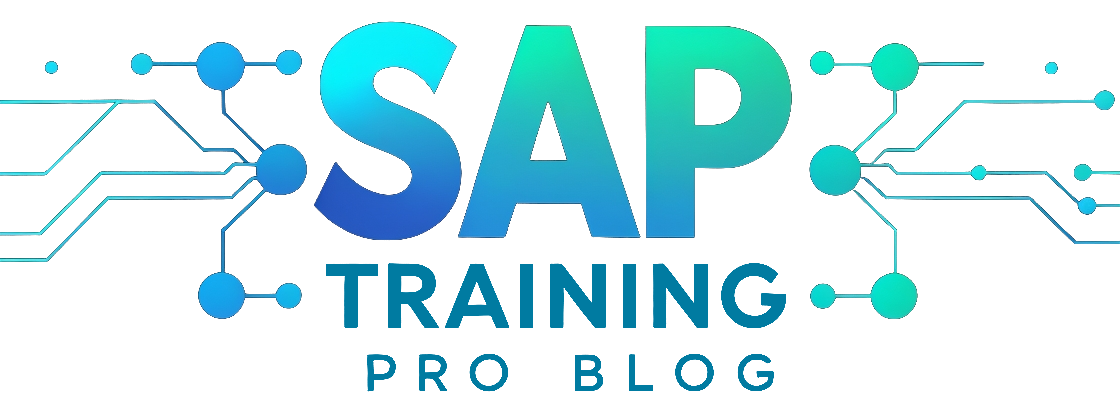Stay Ahead of the Game with SAP Trends in 2023

Stay ahead of the game with SAP trends in 2023 and beyond. In this article, we will explore the latest trends in SAP technology and how they can help businesses stay competitive in the ever-evolving digital landscape.
Table Of Content
SAP, a leading provider of enterprise software solutions, is continuously innovating to meet the changing needs of businesses. By staying up-to-date with the latest trends, organizations can leverage SAP technology to optimize their operations, enhance decision-making processes, and drive business growth.
One of the key trends in SAP technology is the adoption of cloud-based solutions. With cloud computing becoming increasingly popular, businesses are leveraging SAP’s cloud-based solutions to streamline their operations, improve scalability, and reduce costs. By moving their SAP systems to the cloud, organizations can benefit from increased flexibility, enhanced security, and simplified IT management.
Another trend shaping the future of SAP is the integration of artificial intelligence (AI) and machine learning (ML) technologies. By harnessing the power of AI and ML, SAP systems can analyze vast amounts of data, extract valuable insights, and automate decision-making processes. This enables businesses to make data-driven decisions faster and more accurately, ultimately improving efficiency and driving innovation.
Intelligent automation is also revolutionizing SAP systems. By automating repetitive tasks and reducing errors, intelligent automation enhances business processes and frees up valuable time for employees to focus on more strategic activities. Robotic process automation (RPA) is a key component of intelligent automation, allowing businesses to automate manual tasks, improve accuracy, and achieve cost savings.
Furthermore, cognitive computing is transforming SAP systems by enabling them to understand and interpret unstructured data. By leveraging natural language processing and machine learning algorithms, SAP systems can analyze text, images, and voice data, leading to more accurate insights and predictions. This empowers businesses to make informed decisions based on a deeper understanding of their data.
Blockchain technology is also gaining traction in SAP systems. By leveraging blockchain’s decentralized and immutable nature, businesses can enhance transparency, security, and traceability in their operations. Blockchain integration in SAP systems can streamline supply chain management, facilitate trusted transactions, and enable efficient collaboration between stakeholders.
Lastly, the Internet of Things (IoT) is revolutionizing industries and transforming SAP systems. By connecting devices and collecting real-time data, IoT enables businesses to optimize processes, improve maintenance, and enhance customer experiences. In sectors such as manufacturing and logistics, IoT-enabled devices and sensors provide valuable insights, enabling predictive maintenance, real-time tracking, and inventory optimization.
In conclusion, staying ahead of the game in 2023 and beyond requires businesses to embrace the latest trends in SAP technology. By leveraging cloud-based solutions, AI and ML integration, intelligent automation, blockchain integration, and IoT, organizations can drive innovation, improve efficiency, and stay competitive in the digital era.
Cloud-based Solutions
Cloud-based solutions have emerged as a game-changer in the world of SAP technology. With the ability to store and access data and applications remotely, businesses are now able to streamline their operations and improve scalability like never before.
One of the key advantages of cloud-based solutions is the flexibility they offer. Companies can now easily scale their SAP infrastructure up or down based on their needs, without the need for expensive hardware investments. This not only saves costs but also allows businesses to adapt quickly to changing market demands.
Furthermore, cloud-based solutions enable seamless collaboration and data sharing across different departments and locations. With real-time access to information, decision-making becomes faster and more efficient, leading to improved productivity and customer satisfaction.
In addition, cloud-based solutions provide enhanced security measures to protect sensitive data. With robust encryption and regular backups, businesses can have peace of mind knowing that their information is safe from cyber threats.
Overall, cloud-based solutions are transforming the SAP landscape and empowering businesses to stay ahead of the competition. By leveraging the power of the cloud, organizations can streamline their operations, improve scalability, and drive innovation in the digital era.
Artificial Intelligence and Machine Learning
Artificial Intelligence (AI) and Machine Learning (ML) are transforming the SAP landscape, bringing a new level of efficiency and intelligence to businesses. With the integration of AI and ML in SAP systems, organizations can revolutionize their data analysis and decision-making processes.
AI and ML algorithms can analyze vast amounts of data, identify patterns, and make predictions, enabling businesses to gain valuable insights and make informed decisions. These technologies can automate repetitive tasks, reduce errors, and increase efficiency, freeing up employees to focus on more strategic initiatives.
The benefits of AI and ML in SAP systems are numerous. They can improve forecasting accuracy, optimize inventory management, and enhance customer experience through personalized recommendations. Additionally, AI-powered chatbots can provide instant customer support, improving response times and customer satisfaction.
By leveraging AI and ML in SAP systems, businesses can stay ahead of the game in 2023 and beyond. They can unlock the full potential of their data, make faster and more accurate decisions, and drive innovation and growth.
Intelligent Automation
Discover the transformative power of intelligent automation in enhancing business processes. Through the use of advanced technologies, businesses can now automate repetitive tasks, reducing errors, and increasing overall efficiency.
Intelligent automation leverages artificial intelligence and machine learning to analyze and understand complex data sets, enabling businesses to make informed decisions and take proactive actions. By automating repetitive tasks, employees can focus on more strategic and value-added activities, driving innovation and growth.
With intelligent automation, businesses can achieve higher levels of accuracy and precision, minimizing the risk of human error. This not only improves the quality of output but also reduces operational costs associated with rework and corrections.
Furthermore, intelligent automation streamlines business processes, eliminating bottlenecks and reducing the time required to complete tasks. This increased efficiency allows businesses to respond quickly to customer demands and market changes, gaining a competitive edge in the industry.
In conclusion, intelligent automation is revolutionizing business processes by automating tasks, reducing errors, and increasing overall efficiency. By leveraging advanced technologies, businesses can stay ahead of the game and drive success in the ever-evolving market landscape.
Robotic Process Automation
Robotic Process Automation (RPA) is revolutionizing the way businesses operate in SAP systems. By automating repetitive tasks, RPA not only improves accuracy but also significantly reduces processing times. This allows organizations to streamline their operations and achieve higher levels of efficiency.
One of the key benefits of RPA in SAP systems is improved accuracy. Robots can perform tasks with precision and consistency, eliminating human errors that often occur due to fatigue or distractions. This ensures that data and processes are handled accurately, leading to better decision-making and improved overall performance.
Another advantage of RPA is faster processing times. Robots can complete tasks at a much faster rate compared to humans, enabling organizations to achieve higher productivity levels. This not only saves time but also allows businesses to meet tight deadlines and deliver results more efficiently.
In addition to accuracy and speed, RPA also brings significant cost savings to SAP systems. By automating repetitive tasks, organizations can reduce the need for manual labor, resulting in lower operational costs. This allows businesses to allocate resources more effectively and invest in other areas of growth and innovation.
Cognitive Computing
Cognitive computing is a game-changer in the world of SAP systems. By harnessing the power of artificial intelligence and machine learning, SAP systems are now able to understand and interpret unstructured data like never before. This means businesses can gain more accurate insights and make predictions with greater confidence.
With cognitive computing, SAP systems can analyze vast amounts of data from various sources, such as social media, customer feedback, and even audio and video files. By processing this unstructured data, SAP systems can uncover hidden patterns, trends, and correlations that may not be apparent to human analysts.
This technology has numerous applications across industries. For example, in the healthcare sector, cognitive computing can help diagnose diseases by analyzing medical records, lab results, and patient symptoms. In the financial industry, it can assist in fraud detection by analyzing transaction data and identifying suspicious patterns.
By leveraging cognitive computing in SAP systems, businesses can make more informed decisions, optimize processes, and gain a competitive edge in the market.
Blockchain Integration
Blockchain integration is revolutionizing the way SAP systems operate, offering numerous benefits to businesses. One of the key advantages of blockchain technology is increased transparency. By using a decentralized ledger, transactions are recorded in a transparent and immutable manner, allowing for greater visibility and accountability.
Enhanced security is another crucial aspect of blockchain integration. The decentralized nature of blockchain ensures that data is stored across multiple nodes, making it highly resistant to hacking and tampering. This provides businesses with a secure and trustworthy platform to conduct transactions and share sensitive information.
Furthermore, blockchain technology streamlines supply chain management by enabling real-time tracking and traceability. With the ability to record every step of a product’s journey, from raw materials to the end consumer, businesses can ensure authenticity, prevent counterfeiting, and optimize logistics.
Internet of Things (IoT)
The Internet of Things (IoT) is playing a crucial role in SAP systems, revolutionizing industries across the globe. By connecting devices and collecting real-time data, IoT is transforming the way businesses operate and enabling predictive maintenance.
With IoT, businesses can create a network of interconnected devices that communicate with each other and share valuable information. This connectivity allows for seamless data exchange, leading to improved efficiency and productivity. For example, in the manufacturing industry, IoT-enabled devices and sensors can optimize production processes by monitoring equipment performance, predicting maintenance needs, and reducing downtime.
Furthermore, IoT in SAP systems enables businesses to collect real-time data from various sources, such as sensors, wearables, and machines. This data can be analyzed to gain valuable insights and make informed decisions. For instance, in logistics and supply chain management, IoT can provide real-time tracking of shipments, optimize inventory management, and improve delivery efficiency.
By leveraging IoT in SAP systems, businesses can stay ahead of the game and gain a competitive edge. The ability to connect devices, collect real-time data, and enable predictive maintenance is transforming industries and driving innovation.
Smart Manufacturing
Smart Manufacturing is revolutionizing the manufacturing industry by leveraging the power of IoT-enabled devices and sensors. These technologies are transforming production processes, reducing downtime, and improving product quality.
With IoT-enabled devices, manufacturers can gather real-time data from their machinery and equipment. This data can then be analyzed to identify inefficiencies and bottlenecks in the production process. By optimizing these processes, manufacturers can increase productivity and reduce costs.
In addition, IoT-enabled sensors can monitor the performance and condition of machinery in real-time. This allows manufacturers to detect potential issues before they lead to costly breakdowns or downtime. By proactively addressing maintenance needs, manufacturers can minimize disruptions and keep their production lines running smoothly.
Furthermore, IoT-enabled devices and sensors can improve product quality by providing valuable insights into the manufacturing process. Manufacturers can track and analyze data such as temperature, humidity, and pressure to ensure that products are being produced to the highest standards. This not only helps to reduce defects but also enhances customer satisfaction.
In summary, IoT-enabled devices and sensors are transforming the manufacturing industry by optimizing production processes, reducing downtime, and improving product quality. By embracing Smart Manufacturing, manufacturers can stay ahead of the game and achieve greater efficiency and competitiveness in the market.
Connected Logistics
Connected Logistics is revolutionizing the way businesses manage their supply chain and logistics operations. With the integration of IoT technology in SAP systems, companies can now benefit from real-time tracking, inventory optimization, and improved delivery efficiency.
IoT-enabled devices and sensors are playing a crucial role in transforming the logistics industry. By connecting various devices and collecting real-time data, businesses can have a comprehensive view of their supply chain, enabling them to make informed decisions and optimize their operations.
- Real-time tracking: With IoT, businesses can track their shipments and assets in real-time. This not only improves visibility but also allows for proactive management of logistics operations.
- Inventory optimization: IoT sensors can monitor inventory levels and automatically trigger reorder points, ensuring optimal stock levels and reducing the risk of stockouts or overstocking.
- Improved delivery efficiency: By leveraging IoT data, businesses can optimize delivery routes, reduce transit times, and enhance the overall efficiency of their logistics operations.
Connected Logistics powered by IoT technology is transforming the logistics and supply chain management landscape. With real-time tracking, inventory optimization, and improved delivery efficiency, businesses can stay ahead of the competition and meet the ever-increasing customer demands.


